Thanks to the Wellsville Historical Society for permission to post the following pictures.
The Bus station which opened in 1942 was located at the northwest corner of East 5th street and Walnut Street.
Traffic congestion would not have been so severe had the city retained the efficient mass transportation system of earlier years. During the 1950s a comprehensive bus transportation system still operated in the "Crockery City." In December 1955 C.A. Smith, who had operated the former street railway system in the city, sold his forty-six bus Valley Motor Transit Company to the Tri-State Transit Company. By 1957 three transit companies operated in the city. The Holtz Transportation Company served the east end, Pleasant Heights and Wellsville. The Tri-State Transit Company maintained routes to Chester and Newell while the Inter-City Transit Company served the St. Clair Avenue area north of the city. All three operated from the bus terminal on East Fifth Street. Between 1958 and 1962 the Holtz firm ceased operations. Holtz's former routes were taken over by the other lines. In 1962 the remaining transit companies abandoned the terminal because of rising costs and used the "Diamond" as a common center for their various lines. During the mid-1960s the two firms merged into one under the name of the Tri-State Transit Company. Hills and Kilns page 381.
By 1969 the long gradual decline of mass transportation in East Liverpool began to take its toll. The decline was blamed on the increase of private automobiles and the dual problem of rising costs and decreasing revenue. Complaints about noxious fumes and smoke from buses going up St. Clair Avenue or Lisbon Street and lack of adequate service were numerous. In September John Campbell of the bus company said he was unable to rectify the problems because of the lack of revenue. The editor of The Review attempted to encourage citizen support of the buses. He said the system played an important role in transporting youths and senior citizens, it reduced traffic congestion and parking demands, and was important for bringing district shoppers into the city. In 1970 traffic congestion as a result of the closing of the Chester Bridge worsened the situation and one by one various routes were terminated. East Liverpool applied for a $265,000 Federal grant in 1974 to aid in establishing a $321,00 modernized mass transit system. The city planned to purchase the Tri-State Transit Company and use it as a nucleus for the new system, but when voters defeated a one mill transit levy in September 1974, proposed to fund the city's part of the project, the attempt died. The last bus in East Liverpool covered its route in April of 1977 when the private firm closed. Hills and Kilns page 381
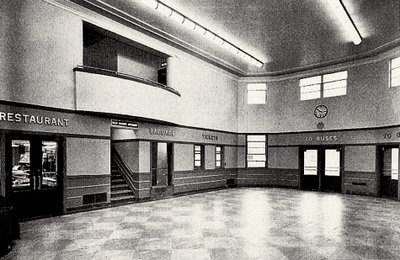
The terminal. During its heyday there were rows of Bench style seats. Along one wall were storage lockers. There was a baggage area as well as modern clean restrooms and public pay phones.
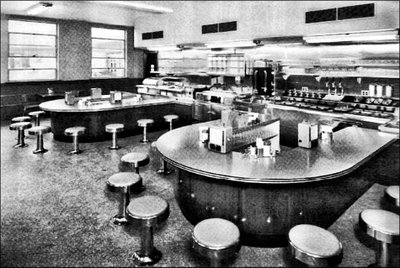
A modern restaurant was part of the terminal.
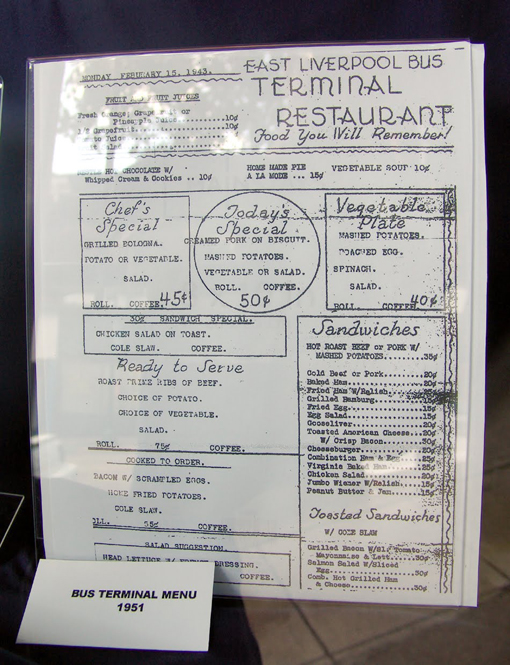
The menu is identified incorrectly here, it is actually a Feb. 15, 1943 menu.

Local buses discharged passengers and took on passengers in the covered area as shown above and immediately below.

Thanks to Michelle Clark Coil for allowing me to post thise pic here. She had originally posted it on "Memories of East Liverpool, Ohio" a Facebook site.
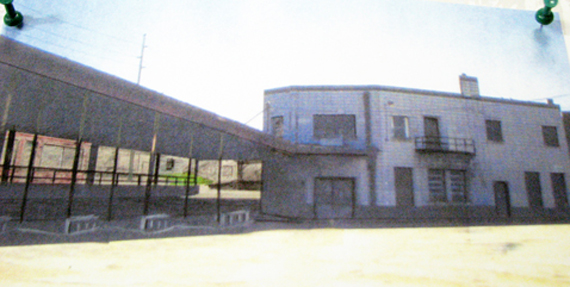
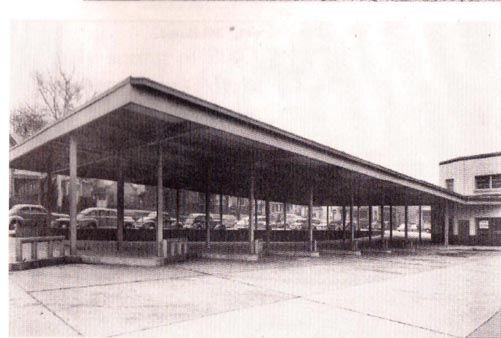
Greyhound buses and other non local buses used the portion of the terminal shown above to take on discharge passengers and luggage.

To the left local buses. to the right Greyhound and other non-local buses.

The Car Barn in the East End was used to park and repair buses. Thanks to Frank Dawson for the one picture above and the two below.


This site is the property of the East Liverpool Historical Society.
Regular linking, i.e. providing the URL of the East Liverpool Historical Society web site for viewers to click on and be taken to the East Liverpool Historical Society entry portal or to any specific article on the website is legally permitted.
Hyperlinking, or as it is also called framing, without permission is not permitted.
Legally speaking framing is still in a murky area of the law though there have been court cases in which framing has been seen as violation of copyright law. Many cases that were taken to court ended up settling out-of-court with the one doing the framing agreeing to cease framing and to just use a regular link to the other site.
The East Liverpool Historical Society pays fees to keep their site online. A person framing the Society site is effectively presenting the entire East Liverpool Historical Society web site as his own site and doing it at no cost to himself, i.e. stealing the site.
The East Liverpool Historical Society reserves the right to charge such an individual a fee for the use of the Society’s material.